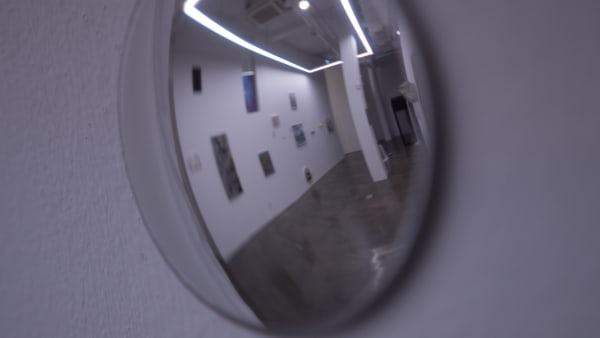Ghost White: 임영주
The title of the exhibition, Ghost White, derives from a brand of translucent white curtains that were created and recently popularized by a blogger. The Korean title incorporates the expression chareureu, an onomatopoeia that evokes a sense of comfort, that the artist here uses to reflect an idea of the simple, ritualistic intent behind his practice. As such, the exhibition is linked to the fragmentation and rearrangement of conventional, everyday symbols.
Besides the ghost white curtains, the exhibition harnessed a multitude of symbols that Im sourced from contemporary popular culture, consumer culture, and Korean folk beliefs. Separated out as individual units, his experiments with these forms were arranged and rearranged within the exhibition space in novel forms. Im’s methodology of mixing disparate symbols in a single exhibition space resembles the methodology of a musical mix, which combines the songs of different artists into a single recording. These diverse images and objects, for which there is no common denominator except the fact that people look to them for comfort or stability, were creatively congregated and arranged across all manner of media, including painting, video, and installation.
But the exhibition incorporates a particular motif besides the methodology of the mix. The multiple images rearranged within the exhibition space all capture a moment of transition or performance. This is immediately evident in the title of the exhibition: Ghost White. The English title is distinct from the Korean original, and it refers to the color and opacity of the curtain. The curtains became popular because they precisely targeted the preferences of consumers in terms of their color and opacity. Chiffon curtains, which had a similar color and feel, allowed too much light to show through and the thinness prevented them from being used alone. The ghost white curtains remedied these shortcomings and were made from a more appropriate fabric. The English title of the exhibition therefore refers to this transition from chiffon curtains to the ghost white curtains.
The point of transition appears more directly in Im’s series of paintings. The cow that is depicted in the series has turned half-white. This borrows from the imagery of the shimudo (In Search of the Cow Painting), a traditional genre of Buddhist painting. Within the traditional Shimudo painting, a young man is depicted in a series of ten panels as he searches for a lost cow, which is posited as representational of his true nature. Im’s painting is a portrayal of one of these panels, in which a golden cow turns white as a result of asceticism. Another painting depicts the ushnisha, the oval protrusion at the top of the head of the Buddha, which represents wisdom. The ushnisha, a mark on the body that represents the Buddha’s achievement of Nirvana, therefore, is the visualization of a particular moment.
The objects installed in the exhibition space have specific meaning relation to folk beliefs and are also linked to notions of transition or performance. Models of dried corvina, painted in gold, are arranged around the exhibition space, and in one corner the Chinese ideogram for king is hung upside down. These all were folk items placed in the households for the purpose of warding off ill fortune and evil spirits. The dried pollack and the Chinese ideogram for king were believed to exist somewhere between the realm of the living and the dead. The dried pollack, which resembles a mummified corpse, is offered up to evil spirits in place of the human body, and the strength of a monarch is used to ward of the evil spirits. The transition from the realm of humans to that of spirits, and vice versa, was therefore represented within the show through these inclusions.
The images and objects that symbolize this moment of transition share a common characteristic. It is that this mode of transition may appear to be quite abrupt to people who do not share these folk beliefs. As the cow that turns white through ascetic practices might seem absurd, the onomatopoeia associated with the chareureu curtains can seem out of place for people who are not aware of their popularity. And for Korean audiences, they might expect to encounter dried corvina and the Chinese character for king, remnants of old superstitions, at random and abrupt moments like when we move into a new home.
However, what is more important is that the diverse beliefs and hopes associated with the products and images are active in completely unrelated contexts, regardless of how arbitrary their source is. The onomatopoeia, chareureu, interjects itself in the product in a way that seems out of place, and similarly, all fads might seem out of place. Nevertheless, nobody would deny the power of fads. Regardless of whether or not the evil spirits consider the dried corvina as human body parts, the items, at least for those who believe in the superstition, provide a sense of comfort.
Im’s method of blending together objects in exhibition that once held a spiritual significance invites the audience to delve into the fantastical moments of transition and performance he references, while at the same time demands that the audience distance oneself from these things. As such, the exhibition touches upon both the extremes of hypnosis and wakefulness and leads us to deeply reflect on the meaning of the current foundations of our lives.


